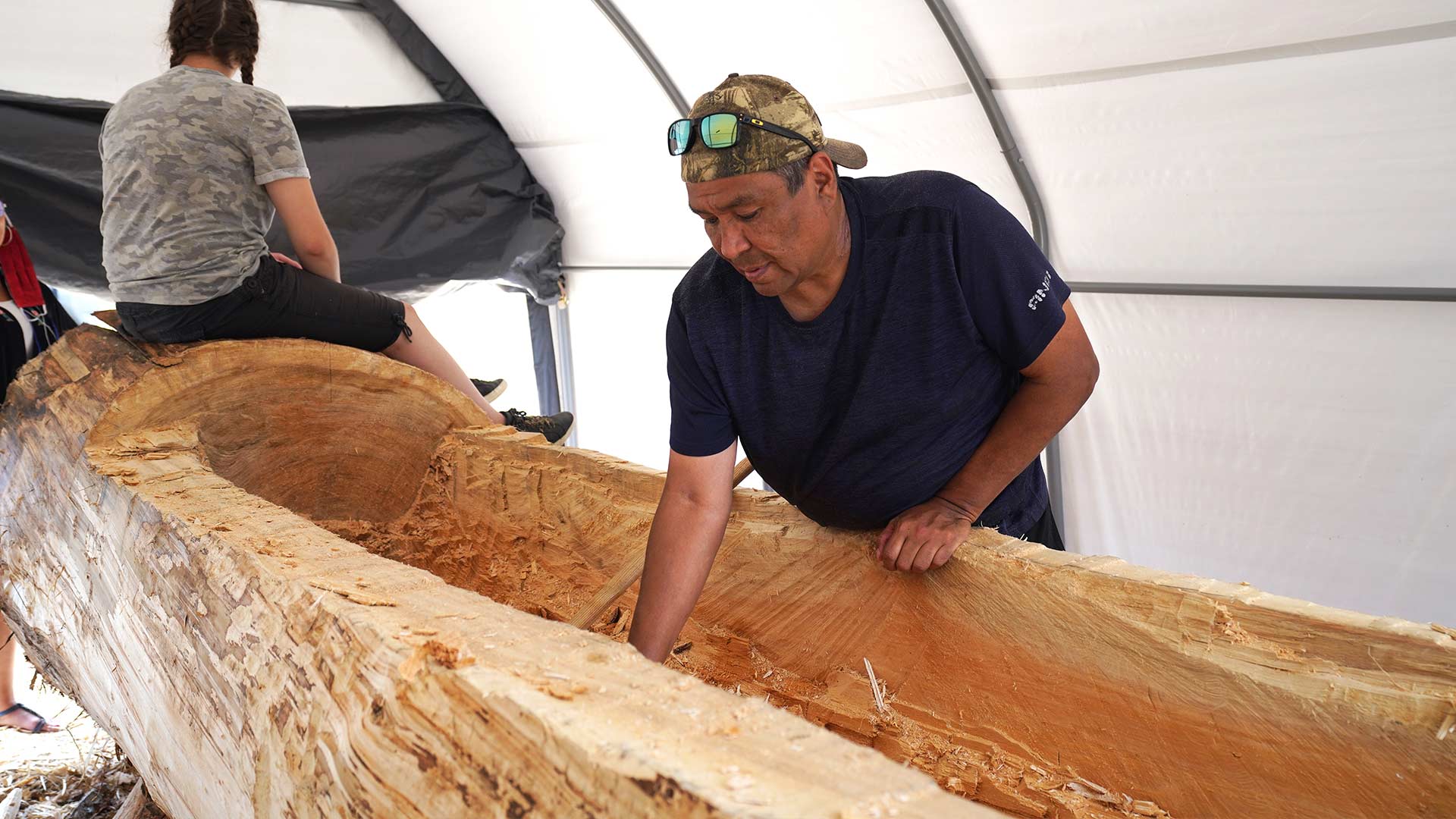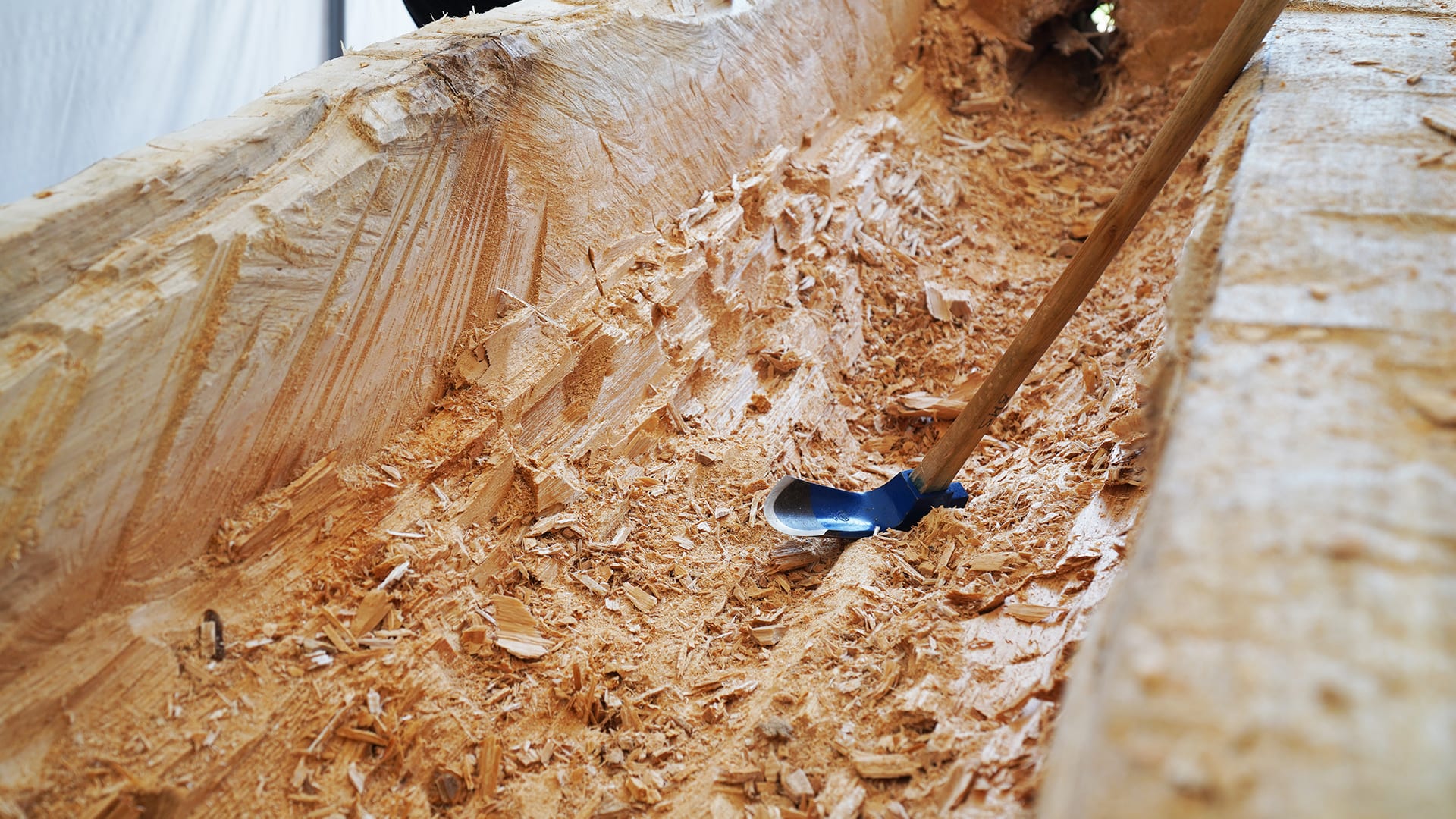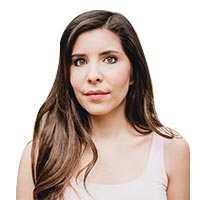
Westbank First Nation youth working with canoe carvers Frank Marchand and William Poitras. Photo by Chehala Leonard/IndigiNews
It’s a hot summer afternoon in July as canoe carver Frank Marchand and his apprentice William Poitras work under an open tent protecting them from the sun and covering their 272 kilogram canoe.
Surrounding them is a small group of Westbank First Nation (WFN) youth, who are participating as part of the WFN youth works program, which provides cultural and traditional learning for those aged 12 to 18.
As of now, they’re three weeks into the six-week project. To meet COVID-19 pandemic measures, they are social distancing, wearing masks and working in an outdoor space.
“These kids come here for two hours on Tuesdays and Thursdays and that’s all they get to do, is two hours of work,” says Marchand.
“They all take turns chopping and they all take turns helping clean up a little bit and the kids are doing good. Westbank First Nation has a good youth group and is run by Saige [Werstuik] and Justin [Derickson], and I think they’re doing really good work.”
Marchand, who remembers when the main form of transport for Elders was canoe, says this project is a way to offer what he learned from his family to a younger generation.
“The canoe culture is what I’m trying to bring back,” he says. “My dad got to go so far while he was here and he’s gone now. In 2009, he’s passed on.”
He explains that he was afraid of canoe culture being forgotten and that’s what also pushed him to get it back into the schools. Encouraged by Elder Louise Gabriel in 2002, he began working with school districts in recent years in West Kelowna and Kamloops in hopes of keeping the custom alive.
“We’re all focused on language, and other customs, such as berry picking and hunting and drying fish and smoking fish and drying meat, and smoking meat. But everybody keeps forgetting about the canoe culture,” he says.
“I took it upon myself to try and get into the schools. The last few years has been a whirlwind of canoes. I think it’s a very good creative outlet for the kids. It shows them how to work. It shows them what, you know, it gives them some pride and self-pride on the canoe building, [and] of what it’s gonna look like at the end. … As long as the kids have fun, we’re doing good.”

Finding cultural pride
For Sydney McDougall, a WFN youth, participating in building a canoe means “to be proud of my culture.”
Fellow WFN youth Jordan Frei agrees, adding, “It makes me feel energetic and that’s a good reason to wake up in the morning on summer vacation. Just that it’s hard labor, and I’m getting to build something that the community can use.”
Although canoe culture has existed for thousands of years, and part of the tradition was in the physical work it took, there are now modern-day technologies to help with the process.
“We have it easy,” says student Jacob Seddon. “Like we have trucks, we can just fill up the back of the truck and dump off all the wood, but our ancestors, they had to, like, take up all the wood by themselves and actually cut down the tree with an axe.”
Seddon, who saw a canoe being made once before on Haida Gwaii, has felt the itch to get involved ever since.
“Before, I was just looking at the people who made it, but now I’m actually making the canoe,” he explains.
Derickson, the founding member of the youth council for WFN, says he is proud of all of the kids involved. More than anything, he says, it’s been important for them to learn about their culture in a hands-on way.
“I think [my] favorite part is just kind of reclaiming the culture and reclaiming what we’ve lost, and how we also get to do it from knowledge keepers like Frank and like Will, who are able to share this with us,” says Derickson.
“And so we got to create this community effort to build, you know, something significant that’s going to be around in this community for a long time.”
Ceremony and process
Creating a canoe from start to finish takes about six weeks. The group holds a ceremony when they bring the canoe into the lake for the first time.
Derickson says the transformation of log to canoe is “pretty incredible to witness.”
“I remember when we came up, this thing was just a log sitting here and it was just a giant log. And then you look at that and you’re thinking, one day that’s going to be a canoe and now already through, what are we, three weeks now, and already you can see the progress,” he said.

At this part of the process, the head of the canoe is being carved out into the shape of a coyote head. They are naming it kwkeyuma? Snk’lip, which means little coyote.
Poitras, who is working as an apprentice, explains that on the day before they started carving, a baby coyote visited the grounds and was found hiding under the log.
“So we named it little baby coyote,” he says. “So, and that’s where, when we’re trying to figure out the shape of the head or the shape of it, I was like, ‘Hey, we have to fill in this part. Let’s make, that’s like, I can carve this into coyote heads and just gives you a little bit more character.’”
He says that the canoes they were working on earlier this year with other school districts have been on hold due to the COVID-19 pandemic for several months, and because of summer break. Due to distancing measures, students were sent home and unable to participate in the canoe building.
“Hopefully, in September, we’ll be able to start up again on those canoes. We just shut them down. We’re probably about 90 per cent done both of them,” says Poitras.
In the meantime, WFN, which is better able to practice safe distancing as they are working in an outdoors space, will complete their current canoe project by the end of August.
Derickson says, “The plan is, at the end of the summer, when the youth works program is finishing up and we’re wrapping up everything, we’re going to have a giant canoe celebration down at the water and it’s going to be a big ceremony and we’re going to launch it off into the Lake.”
The students say they can’t wait.
“[I’m] happy that we’re doing our traditions,” says Seddon. “When it comes to an end, we have even more fun just riding around in the canoe.”
Chehala is reporting from the Okanagan for The Discourse as part of the Local Journalism Initiative. She’s a journalist and documentary producer from the Aseniwuche Winewak Nation, near Grande Cache, Alberta. Her work is featured on IndigiNews.com, a new platform created by The Discourse and APTN.











